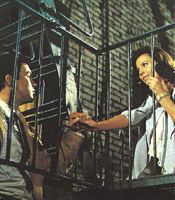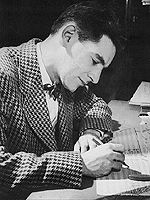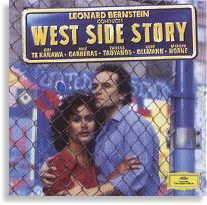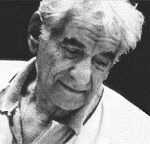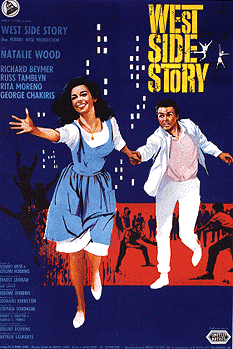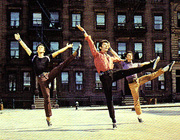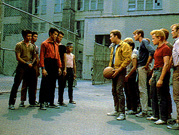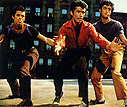|
|
minhas.net |
|
This
is the home of:
www.minhas.net www.minhasfamily.com www.jagminhas.com www.jagandjaz.com |
| __________________________________________________________________ | |||
|
West Side Story! When Broadway legend Jerome Robbins conceptualised the idea of musicalising Romeo and Juliet within the context of contemporary New York City gangs, he approached librettist Arthur Laurents with the idea. The two then joined forces with musical genius Leonard Bernstein to create the now-legendary West Side Story.
Making his broadway debut, a 27 year old Stephen Sondheim provided the lyrics. The show had diffucult birth pains, losing a producer along the way, but when it opened at New York's Winter Garden Theatre on September 26, 1957, it changed the face of musical theatre forever. The next stop was to head west to make the film version. The broadway musical has had a tortuous relationship with Hollywood: the trip from East to West coast rarely leaves material intact. Dozens of stage masterpieces have ended up as white elephants of celluliod, raising the frequent cry, "Why couldn't they have done it right?" In the 30's and 40's stage shows were truncated and many songs were removed. In the 50's, 60's and 70's, many ended up grossly miscast or overblown. The 80's gave us hardly any at all; the two biggest musicals were directed by men who had achieved a higher level of success in other genres. Luckily, West Side Story was transferred to the screen virtually intact. Robbins had been engaged to co-direct and cheoreograph the stage landmark he had natured from a small idea into a phenomenon. The film edition went on to net not only a huge box office return but 10 Academy Awards, including Best Picture. Its soundtrack album remained on the Billboard chart for years, and the film had two major U.S. theatrical reissues before premiering on NBC-TV in 1972. West Side Story - The Musical
"New York, Jan 6. 1949 Jerry R. called today with a noble idea: a modern version of Romeo and Juliet... And it all fits, the Montagues and Capulets will be rival street gangs, the Jets and the Sharks. Friar Lawrence is a neighborhood druggist, street brawls, and a double death ..." Sounds familiar? No, it does not star Leonardo Di Carprio. In fact, when West Side Story was premiered in 1957, Leonardo's parents wouldn't even have met. The collaboration of young American musical prodigy Leonard Bernstein, the talented choreographer Jerome Robbins, the gifted lyricist Stephen Sondheim and writer Arthur Laurents - West Side Story could hardly ever have a chance to be anything less than a smash hit. "...the bigger idea of making a musical that tells
a tragic story in musical-comedy terms ... never falling into the operatic
trap" The team set out with a vision, to change the face of American musical theatre. Music historians looking for a true blue American opera have already missed Gershwin's Porgy and Bess and Bernstein's earlier collaboration with Lillian Hellman in Voltaire's Candide. I will not consider West Side Story an opera, but it comes close to it with the "seriousness" of musical composition and demanding vocal parts for the leads, which are written as if for operatic singers (the extended high B-flat for tenor in "Maria" for example). Of all the contributions of American culture to the arts, the Broadway musical is one of the most significant. Its predecessor, the European operetta (a play with spoken dialogue but abundant singing in operatic style), typically featured exotic settings, aristocratic characters, and wildly improbable plots. Although the musical's roots were in England, it quickly evolved in the hands of such geniuses as Irving Berlin, Jerome Kern, Richard Rogers and Lorenz Hart and the incomparable George and Ira Gershwin into a distinctively American form featuring popular songs, many of which were to become "standards," still widely performed and loved today. Leonard Bernstein took the musical to new heights of seriousness in his 1957 production, West Side Story, based loosely on Shakespeare's Romeo and Juliet. Its true subject was the growing menace of gang warfare (or "juvenile delinquency" as it was known then) in the context of racial tensions created by clashes between whites and Puerto Rican immigrants. Consciousness of racism was very much on the rise in the U.S. of the late fifties; and Bernstein, a life-long liberal, wanted to portray the issue in an uncompromising fashion. The subject is treated in a fairly complex fashion. Note especially "I Want to Live in America," which expresses the ambiguous feelings of the immigrants about their homeland while forthrightly condemning American white racism. Originally the script was to have dealt with a Catholic/Protestant romance, but Bernstein decided to choose a more immediately relevant theme. Ironically, neither Broadway nor Hollywood was able to rise above its own institutionalised racism to cast a Latina actress as Maria. The gangs of that time were much less well armed than today's, and the exigencies of stage and film production in the fifties forced the libretto to use somewhat censored language (somewhat dated now, but fairly hip then), so that the modern viewer may be tempted to look at this story of gang warfare as somewhat innocent and naive. But at a deeper level, the hatreds and frustrations articulated here are authentic reflections of an ongoing American tragedy. West Side Story features classic dances by Jerome Robbins, especially in the hyper-athletic masculine style pioneered by choreographer Agnes de Mille in Rodeo and Oklahoma , and several extraordinarily beautiful songs, many of which have become classics. Bernstein, at this time the most famous conductor in the world, leading the New York Philharmonic, and exponent of a wide range of classical and popular music, had the skills to write music considerably more complex that contained in most musicals. If a musical is not an opera, neither is it a play. It is necessary to accept the fact that characters are constantly bursting into either song or dance. It is in these songs and dances that the very essence of the musical exists. West Side Story opened at the Winter Garden Theatre on September 26, 1957 and ran for 732 performances before going on tour. The 1961 film version featured Richard Beymer, Natalie Wood, George Chakiris and Rita Moreno. Leonard Bernstein Conducts WSS A 1984 Recording: Maria: Kiri Te Kanawa soprano The original 2CD set now available on single CD with full liberetto. Not to be confused with Selections from the musical also available on single CD. Includes full libretto in English, French and German.
Known amongst Bernstein fans as the "operatic version" of West Side Story, it features a stellar cast consisting of Dame Kiri Te Kanawa (Maria), Jose Carreras (Tony), Tatiana Troyanos (Anita), Kurt Ollman (Riff) and Marilyn Horne who sings "Somewhere" through an unnamed character in the show. This also features Leonard Bernstein conducting his own music for the very first time.
"August 25, 1955 ... Suddenly it all springs to life, I can hear the rhythms and pulses, and - most of all - I can sort of feel the form..." Not that the Broadway cast recording or the movie soundtrack to the Oscar-winning film version are no good, but listening to this rendition is a revelation. Dame Kiri Te Kanawa breathes new life into her character as she vocalises every phrase of Bernstein's music with such musical sympathy. This was music she grew up on, she says in an interview from West Side Story: The making of the recording (also available on video casette and VCD) even before she took singing seriously. On the other hand, we have Spanish Jose Carreras whose discomfort with the language and culture of the music are clearly audible but whose musicianship and voice is no less than magnificent. "Maria" is a song that has been sung in so many ways by a many singers, but to hear Carreras sing it is heart wrenching. The cadenza-like, lovelorn rhapsodising on the name "Maria" finally receives justice in this rendition, as Carreras' passionate delivery is easy and confident. Surely, the most moving song in here is "One hand, one heart", a duet sung by Te Kanawa and Carreras. If you already know the sad ending of the story, this scene where Tony and Maria have a make-believe wedding at a bridal shop will be enough to move you to tears. Leonard Bernstein's music communicates directly with the heart; his uncanny understanding of the effect of music in the theatre prevails through the bittersweet melody and beautiful orchestration of the accompaniment. Adding to all that here is the mastery of the phrase and the inspired singing of the two leads that leaves the listener spellbound till the end of the song. Tatiana Troyanos' Anita is Maria's nurse, a fiery lady of Puerto Rican descent. She leads her girls in raucous account of the humorous and contagiously rhythmic "America", possibly the most triumphant take on this recording. The lively 'fiesta' atmosphere is captured wonderfully by the orchestra and chorus, a spontaneity that makes you want to jump out of your seat and dance! Her duet with Te Kanawa on the acerbic "A boy like that" deserves mention as well. They capture Anita's love for Maria leading to her change of loyalty, which is a great dramatic consequence to the rest of the musical, from angry outbursts to her sympathy towards the love of the young couple even while it forebodes the tragic outcome. Kurt Ollman's contribution as Tony's pal Riff is less significant, though his portrayal of the rash belligerent gangster that is contrasted with the more "Romantic" Tony is very effective. "July 8, 1957 ... I guess we were right not to cast "singers": anything that sounded more professional would inevitably sound more experienced, and then the "kid' quality would be gone. A perfect example of a disadvantage turned into a virtue." I'm sure Bernstein himself would have begged to differ at the outcome of this recording. Certainly, the 'kid' quality is gone, replaced by lovers who can so beautifully articulate every nuance of the music. Perhaps the staging of this is theatrically unfeasible but the music is just so good that it justifies the release of this version. Whether intentionally or otherwise, the supporting orchestra and chorus who perform so wonderfully is not even named. Gramophone quotes from unknown sources that the orchestra was formed by "some members of the New York Phil" and others. The versatility of the playing is amazing as they tackle vaudeville numbers, hot Latin-American numbers, snappy jazzy tunes and symphonic writing with equal ease and proficiency. The male chorus members, cast as the Jets, deliver a very funny "Gee, Officer Krupke" and the female choir accompanies Troyanos' "America". All in all, a highly professional team except for Nina and Alexander Bernstein (daughter and son of LB), who do the narrative (spoken) parts of Maria and Tony with fake Puerto Rican accents and contrived delivery of lines. I think this is one of the most distinct flaws in this otherwise definitive rendition of the music. "Washington D.C. Aug 20, 1957 ... I laughed and cried like I never seen or heard it before. And I guess what made it come out right is that we all really collaborated; we were all writing the same show... Now a whisper about a happy ending was heard. A rare thing on Broadway." Lenny voices what must have been the opinion of the creative geniuses who worked on West Side Story. The composer's work can be acclaimed on all fronts: Jerome Robbin's brilliant choreography and direction is well-known in the many critical successes in classical dance and on Broadway throughout his lifetime. In retrospect, the then young talent Stephen Sondheim had already received legendary status in the American musical and song-writing scene with landmark works like Sweeney Todd and Into the Woods. Even so, I'm inclined to say that it is Lenny's music that is truly the backbone of West Side Story; this music when presented with true understanding under his own baton communicates with everyone, from the elitist "Classical music lover" to the layman alike. Indeed, this is the mark of a great work; reminiscent of the reception Bizet's Carmen received at its premiere. For all we know, the masterpieces of the American musical theatre will be hailed as great art by future generations as opera is today. "I am proud and honored to be part of it" It is known that Bernstein never wanted to be remembered as a composer for his work in West Side Story, as much as he loved it. He wanted to be remembered for "serious" works like his symphonies, the "Kaddish" and "The Age of Anxiety". His theatrical ventures have always received more praise than his "serious" compositions, much to his disappointment. It is surprising indeed that a man who was known to spread the joy of music to so many that he worked with and taught, through concerts, masterclasses or television broadcasts, felt so strongly about the need to have written good "serious" music. West Side Story is as successful a piece of music as any serious composition that I have ever heard. Especially in this CD, it deserves to be appraised in a new light. It makes you laugh and cry with it, touching subtly on social themes and of the noblest notions of Romantic love. History will remember Leonard Bernstein as the most important American musical force in the 20th Century, one of the greatest conductors that has ever lived, one of music's greatest teachers ... and the man who gave the world West Side Story.
LEONARD BERNSTEIN (1918-1990) West Side Story - history and factfile Plans for one of the greatest musicals of all time were originally shelved due to Leonard Bernstein's other commitments. But, eight years later, after a faltering start and a change of name, West Side Story burst triumphantly on to the stage. In 1949, dancer and choreographer Jerome Robbins suggested to composer Leonard Bernstein that they join forces on a modern musical version of Shakespeare's Romeo and Juliet. The play had already been adapted for opera and ballet and he thought the love story, set against a background of family feuds, had universal appeal. Robbins proposed that they update the plot using a Jew and a Catholic as the main characters. He named the project East Side Story and called in writer Arthur Laurents to work on the libretto. Bernstein, though initially enthusiastic, decided he had too many other commitments and the project was put to one side. Second thoughts Six years later, meeting by accident in Los Angeles, Bernstein and Laurents again discussed the project. On this occasion, Laurents fired Bernstein's imagination by suggesting that they use a black and a Puerto Rican as the hero and heroine caught in the middle of street gang rivalry. Laurents looked out his old libretto and Robbins was contacted. Stephen Sondheim was enlisted to write the song lyrics, despite his protestation. 'I've never even known a Puerto Rican'. The creative team was now in place. This was to be a collaboration, not, as Laurents put it, just a 'god-damned Bernstein opera'. Laurents stuck as closely as he could to Shakespeare's original plot: the star-crossed lovers became native New Yorker Tony and Puerto Rican immigrant Maria; Shakespeare's Montagues and Capulets became rival gangs the Jets and Sharks; and the great love scene was transposed from balcony to fire escape. To make the characters timeless yet realistic, Laurents invented a special street language, as he felt contemporary slang would date the piece. He even pre-empted the widespread use of 'cool', which was not modified into its slang form until several years later. Working together Laurents planned the musical numbers very carefully. With the exception of 'Gee, Officer Krupke', which is pure light relief, every song arises from one of the three dramatic situations in the show: the feud between the Jets and the Sharks, Tony and Maria's mutual love and Anita's remonstrations with Maria. Robbins too wanted his work to be as integrated as possible with the other elements of the show. The routines he developed were street-wise and vibrant with alternately crouching and leaping dancers performing athletically to Bernstein's Latin American-inspired cross-rhythms, mambos and cool jive. It took two years to bring the show to the production stage, during which time each of the collaborators was involved in other projects. Bernstein completed Candide, Robbins directed Bells are Ringing, Laurents had his play A Clearing in the Woods produced and Sondheim worked on TV shows. Living the part Although Sondheim claimed the show was changed less than any other musical he was involved with until Sweeny Todd, the production was not without problems. The original producer, Cheryl Crawford, dropped out six weeks before rehearsal and Harold Prince - later to become a great Broadway director - took over at the last minute. Robbins hired young dancers who, while fitting the age profile of the piece, had little acting experience. To make them act like real street gangs, he encouraged them to live out their stage roles, even to the extent of not socialising with members of the other gang. It worked so well that one cast member complained that no one would eat with her. The show opened in Washington, U.S.A., to mixed reviews from the critics. When it moved to Broadway, though, it was an artistic triumph and was commercially successful. A star is born West Side Story also made a star both sides of the Atlantic of Dolores Conchita del Rivero - better known as Chita Rivera. Her skilful dancing and Latin temperament were perfect for the part of Anita and she went on to have roles in Chicago, The Rink and Kiss of the Spider Woman specially created for her by the great composer/lyricist duo of John Kander and Fred Ebb. West Side Story ran on Broadway for 734 performances before embarking on a national tour. Harold Prince planned the tour at the point when he felt audiences were falling off. At the same time, he made tickets available at a discount price. After the tour, in a daring move, he brought the production back to Broadway. kept ticket prices low, and the show ran for a further 249 performances, bringing the total to just under 1,000. From cult to smash hit In 1961, producer Robert Wise made West Side Story into a memorable film, which Sondheim credits with transforming the show from a cult to a smash hit. Starring Natalie Wood, Richard Beymer and George Chakiris, it is widely acknowledged as one of the finest movie-musicals of the 1960s. The film was awarded 10 Academy awards, including 'Best Picture', and a special award went to Jerome Robbins 'for his brilliant achievements in the art of choreography on film'. The film also made stars of Rita Moreno and George Chakiris, a member of the original London stage cast. Both received 'Best Supporting Actor' Oscars, while Irene Sharaff was honoured for her costumes. On record West Side Story has been recorded frequently. In addition to the original Broadway cast album and the film sound track, there have been several 'highlights' editions. The 1985 version starred opera singers Kiri Te Kanawa, Jose Carreras and Marilyn Horne and was conducted by Bernstein himself. West Side Story has stood the test of time as a result of consummate
team work. As Bernstein wrote in his diary on the day of the Washington
opening, '... what made it come out right is that we all collaborated,
we were all writing the same show.' The Music of West Side Story Click here for the lyrics of the
songs. Acknowledgements Permission pending from Tim Dirks of http://www.filmsite.org Permission pending from Adrian Tan of the Inkpotters classical music section. Related Links The official WSS website: Deutsche Grammophon CD of "Bernstein Conducts West Side Story" and also the DVD of the making of "Bernstein Conducts Westside Story". ChoicesDirect - a UK music-video specialist who carries the above in VHS format. Stephen Sondheim Home Page |
West Side Story - The Movie West Side Story (1961) is an energetic, widely-acclaimed, melodramatic musical - a modern-day, loose re-telling of Shakespeare's Romeo and Juliet tragedy, although the setting is the Upper West Side of New York City in the late 1950s.
Like many other musicals of its time, Hollywood again looked to this successful Broadway stage play for its source material (e.g., in earlier years, South Pacific (1958), Oklahoma! (1955), and Carousel (1956) were chosen, among others), realising tremendous competition from TV and other genres of cinematic entertainment. West Side Story is still one of the best film adaptations of a musical ever created, and the finest musical film of the 60s. The ground-breaking film was based on the successful Broadway hit - a staged musical play (opening in 1957) by writer Arthur Laurents and directed/choreographed by Jerome Robbins. The play reworked the traditional love story material (of lovers that crossed racial/ethnic barriers) and translated it, in a radical, novel and revolutionary style for a musical, to include racial strife between rival New York street gangs (newly-arrived Puerto Ricans and second-generation Americans from white European immigrant families), juvenile delinquency and inner-city problems of the mid-twentieth century - in musical and dance form. To capture the realism of the social tragedy and its urban environment, some of the film was shot on location in Manhattan (in West Side tenements and other settings), but most of it was actually filmed on sound stages with stylised, artificial studio sets. The stage book was rewritten and adapted for the screen by Ernest Lehman, and the film retained the beautiful and electrifying musical score, songs and lyrics of Leonard Bernstein and Stephen Sondheim. It was co-directed by veteran director Robert Wise and Jerome Robbins - both shared credit for the film's direction although Robbins was removed after a few months due to schedule delays, disagreements with Wise, and Robbins' potentially-expensive demands for perfection. The four kinetic dance sequences that Robbins choreographed (including "I Feel Pretty" and "America") and the jazzy, interpretative score of Bernstein rhythmically communicate the passionate intensity, frustration and tough violence of the streets. The much-praised, box-office blockbuster for United Artists received eleven Academy Award nominations and won all but one - Best Adapted Screenplay. Its achievement as a ten Oscar winner has only been surpassed by two films (each with eleven Oscars): Ben-Hur (1959) and Titanic (1997). West Side Story's Oscar awards include: Best Picture, Best Director (Wise and Robbins - the first time that awards went to co-directors), Best Supporting Actor and Actress (George Chakiris in his first major film role and Rita Moreno), Best Colour Cinematography, Best Colour Art Direction/Set Decoration, Best Sound, Best Scoring of a Musical Picture, Best Film Editing, and Best Colour Costume Design. Robbins was also awarded a special statuette for "his brilliant achievements in the art of choreography on film." Robert Wise won his second directorial Oscar for The Sound of Music (1965). The singing of both leads was dubbed: Jimmy Bryant for Richard Beymer, and Marni Nixon for Natalie Wood, and the vocals by Rita Moreno were enhanced by Betty Wand.
During the opening prologue, a breathtaking aerial shot of Manhattan from a bird's eye view captures the city with its bridge traffic and highway ramps, its waterfront docks, parks and skyscrapers. The camera passes over recognisable landmarks as it moves steadily to the Upper West Side of Manhattan, and then speedily zooms down and plunges into a concrete playground. A gang of 'cool' white youths are posed together in one corner of a basketball court, clicking their fingers to the syncopated rhythm of the musical score. The aggressive gang members leave the fenced-in playground and cross the tenement street. In the famous, dazzling opening sequence, they gradually break into a highly-stylised dance and then burst into a daring, high-stepping sequence - an exhilarating, inventive, visual ballet of pirouettes, vigorous athletic moves, and running jumps that symbolises their dominance and energy - they are readying themselves for a gang brawl. They are members of the Jets composed of white teens, led by brown-haired, All-American type Riff (Russ Tamblyn). [They represent one side of the racial rivalry, similar to Shakespeare's tense and feuding families, the Montagues and the Capulets.] Two of the gang members face off against one member of a rival gang, Sharks leader Bernardo (George Chakiris), a darker-skinned, black-haired Puerto Rican immigrant. He is joined by his gang members, and they pick up the beat by clicking their fingers. The gangs both are vying for control of the streets, alternating between dominance and submission. Two of the members provoke each other, and after an extended confrontation, a full-scale brawl breaks out when the Jets come to rescue Baby John (Eliot Feld), the youngest member of their gang, from an assault by the Sharks.
The conflict is broken up by the arrival of a precinct patrol car, carrying uniformed Officer Krupke (William Bramley) and bigoted, plainclothes policeman Lieutenant Schrank (Simon Oakland) who have stopped similar fights between the "punks" many times before. Riff speaks to his gang members and arouses their immature gang mentality. He directs his hatred toward the Puerto Ricans and their turf-encroachment. Convinced of the Jets' own strength and invincibility, he is adamant about checking the Sharks' expansion and influence in the neighborhood while still avoiding a life-threatening rumble with blades or zip guns. However, Riff would consider battling the rivals with weapons if challenged. Riff proposes getting help from Tony, a young Polish boy and ex-leader of the Jets who has grown away from them and taken a respectable job: "We need Tony. He's got a rep that's bigger than the whole West Side...He always came through for us and he always will." Tony could serve as the Jets' lieutenant for the impending showdown: Riff suggests persuading Tony, who founded the gang but has since moved on, to "stand up" with him and the Jets at the local dance and challenge rival gang-leader Bernardo to a rumble. Tony, an ambitious, level-headed young man who is responsibly employed and works for a living at Doc's, the neighborhood drug and candy store, resists Riff's invitation to the dance, to confront the Sharks that "walk bad" and "fight hard" on neutral turf. Riff pleads for one last favor from his idealistic best friend who has left his past behind and dreams of moving on to something "just around the corner". Tony sings: "Something's Coming," a song of expectancy about the coming night: A young, newly-arrived (a month earlier), innocent-looking Puerto Rican girl, Maria (Natalie Wood in her second adult film role), speaks in a heavy accent to Anita (Rita Moreno) while she makes alterations to Maria's dress in the back of Madame Lucia's Bridal Shop. Maria begs her to lower the neckline one more inch on her white dress for the evening's dance. However, Maria's over-protective, "watchdog" brother Bernardo (and Anita's boyfriend), who wants to prevent her from growing up too fast, has already forbidden it: "Bernardo made me promise." Maria's older brother has brought her over to marry Chino (Jose de Vega), but she feels no romantic attraction to him. Bernardo regards his sister as "a precious jewel." Maria is thrilled and excited about her coming out that evening: "It is most important that I have a wonderful time at the dancing tonight...because tonight is the real beginning of my life as a young lady of America." She spins backwards, and a rainbow of colors envelopes her - the background behind her turns black. The gymnasium dance sequence dissolves into view. [Most of the Jets' couples are dressed in light-colored party clothes, while the Sharks wear darker colors. The Jets dance with more bold movements, the Sharks with sinuous, sleek steps.] Glad Hand (John Astin), a 'square' social worker who has organised the dance, separates the warring factions in the middle of the gym floor, and naively announces to the "boys and girls" (or "kids") something special: a "get-together dance" to "make new friends" and "get closer to old ones.". After a brief stand-off, members of both gangs form two circles and play one round of the game - it fails miserably. Male gang members refuse to dance with members of the opposite sex from the camps of their hated enemies. In the volatile atmosphere, dozens of couples from both gangs display their rivalry and compete for center-stage dance-floor space. Their snappy, exuberant gyrations are shot from a floor-level camera. From across the dance floor, Maria and Tony spot each other and become magically entranced - everything around them is blurred and in soft focus. As the lights around them go out, they are drawn to each other - it is instantaneous love at first sight. As a couple, they perform a light ballet to the tune of "Maria." The black sky behind them is dotted with multi-colored stars. When their romantic reverie ends and the lights come back up, Bernardo pushes the American away from improperly kissing his appealing sister. Maria must abide by her familial obligations. Bernardo orders Chino to take Maria home. Riff uses the incident as an opportunity to call a "war-council" with the rival gang leader. Bernardo accepts the proposal to meet at midnight at Doc's candy-store. As Tony walks from the dance in a love-sick daze and the settings change behind and around him, he sings a lyrical love song about "Maria," his newly-found loved one. "Maria" Now that the lovers are in the midst of increasing conflict between the two gangs, Bernardo lectures at his sister for stepping over forbidden boundaries. On the rooftop of their tenement building, Bernardo's wise and feisty girlfriend claims that the gang leader used Maria's love for someone of a different culture and race as an excuse for the winner-take-all rumble. In contrast to other second generation immigrants, their entry into America as Puerto Ricans was met with disillusionment, prejudice and lies: "When I think of how I thought it would be for us here, we came like children, believing, trusting." The rewards of being an American are materialistic: driving a fancy Cadillac, "air-conditioned," "built-in bar," "telephone" "and television," "compartment of Cola." With the entire Puerto Rican cast on the rooftop, hot-blooded Anita sings
and dances, with biting wit and humor, about her love for her new homeland
in the rousing, lively and aggressive "America." The land of
the free is both a land of opportunity and enmity for new immigrants:
"America" As "an American girl now," the lusty, Puerto Rican spitfire insists that Bernardo choose between his "big important war-council" and her. He selects the war-council, claiming that "back home, women know their place," and that war-councils are held by Americans. That evening, Tony visits with Maria on the tenement fire escape outside her bedroom - the Romeo and Juliet balcony scene - although she knows the danger and cautions him. Despite the hatred and fear of the rival gangs they are connected to, Tony is oblivious to all the potential, obvious, and long-standing difficulties that their inter-racial relationship could cause. They embrace, sing to each other, and join in unison to express their love to each other with the love duet "Tonight," one of the film's most favorite, timeless songs. "Tonight" They decide to see each other the next day after Maria's work in Madame Lucia's Bridal Shop across the street from her home. While waiting for the "war-council" in front of Doc's store, Officer Krupke's squad car drives up, and Krupke wants them to move on instead of blocking the sidewalks. The next bowdlerised song, "Gee, Officer Krupke," mocks the police and blames multiple sources for the causes of juvenile delinquency among youth: poor parenting and role modeling, abuse, drug addiction, alcoholism, and the propagation of unwanted children. The poor victim is shunted from one social institution to another: the police department, a judge in the court system, a therapist and headshrinker, and a social worker. The "punk" is labeled as "no good," "psychologically disturbed," "depraved," and "sociologically sick." Doc (Ned Glass), who returns to his shop, calls the Jets "hoodlums," and thinks that their plans to "rumble" with the PRs over territory is senseless: "Fightin' over a little piece of street is so important?"
The Sharks and the Jets conduct a "war-council" session in the store, peppered with insults and derogatory epithets. The Sharks accept the rumble, planned for the next day "after dark" under the highway. Tony enters the store as they are discussing the call for weapons, with increased tempo and volume: "Rocks, belts, pipes, cans, bricks, bats, clubs, chains..." He interrupts the cadence between the two sides. Now "in love," Tony suggests a rumble that is also a "fair fight if you've got the guts to risk that? Best man from each gang will slug it out." He persuades them to accept a fist fight between the strongest representatives from each side for a decisive, final battle. Bernardo threatens Tony personally, thinking that he will be selected as the representative: "When I get through with you, you will be like a fish after skinning." The prejudiced Lt. Schrank intrudes and is amazed to find the members of the gangs peacefully socialising together in Doc's place. He accepts credit for the relaxation of tensions - although it is a sham - and then viciously throws the Puerto Ricans out. The Sharks exit, whistling "My Country Tis of Thee" as they depart. Claiming that he's for them, Schrank wants the Jets to divulge where the rumble will be held: "I want this beat cleaned up and you can do it for me. I'll even lend a hand if things get rough. Now, where are ya gonna rumble?" He chastises them when no one answers with foul-mouthed insults: "Why don't you get smart, you stupid hooligans? I oughta take you down to the station and throw you in the can right now. You and the tin-horn immigrant scum you come from." As they leave, he threatens to be there at the rumble: "Don't worry. I'll find out where it's gonna be. So be sure to finish each other off because if you don't, I will." In the bridal shop the following day, Maria models fancy hats, coyly agreeing that she is "crazy" in love, "looks somehow different," and "is up to something." She tells her gossipy Puerto Rican girlfriends "what is going on" by singing "I Feel Pretty". Since it is six-o'clock and quitting time, Maria tells Anita that she will be locking up the shop: "I have work." After taking a luxurious bubble bath with Black Orchid, Anita is expecting a date with Bernardo following the evening's rumble between the Sharks and the Jets. Peace-loving Maria doesn't understand the politics of gang warfare. Tony arrives to see Maria - Anita gives both of them a knowing look and a sarcastic rendering of Maria's self-less helpfulness: "I will lock up." She gives them a worried look and warns them about defying loyalties and breaking the rules of their respective societies: "You're out of your heads." Maria urges Tony to go to the rumble as a peacemaker, to stop the fistfight between Bernardo and Ice. They playfully pantomime their engagement and wedding with mannequins that represent the in-laws and other members of their families. With a bridal veil on her head, and a black top hat on his head, they walk down an imaginary aisle in the store and enact their wedding. As a couple, they kneel and exchange marital vows. The setting resembles a church and an altar - the store's window above them with a cross bathed in gold light accentuates the holy nature of their bonding: "'til death do us part." Their soothing duet, "One Hand, One Heart," establishes their oneness as they exchange private vows. The scene abruptly changes to a blood-red sky, and the approach of the combatants, Sharks and Jets, toward their eventual confrontation at the rumble, sung by all gang members. Verses and cross-cut scenes in the same dance and song sequence "Quintet" show paralleling, interwoven events from the perspectives of different characters (the gangs, Anita, Tony, and Maria) as they each face the night. Anita expects to get her kicks in a "private little mix" with her "hot and tired poor dear" Bernardo. Tony sings: "I'll see my love tonight and for us stars will stop where they are." Maria is impatient with the slow passage of time: "Today the minutes seem like hours, the hours go so slowly and still the sky is light. Oh moon, grow bright and make this endless day endless night." The Puerto Ricans scale a tall chain-link fence under the highway. The Jets appear on the top of a facing concrete wall, jump down, and face them. After dispensing with the shaking of hands, Bernardo urges: "Look, every one of you hates every one of us, and we hate you right back. Let's get at it." Tony interrupts the rumble, the hand-fight between Ice and Bernardo, after it has just begun: "Hold it!" He steps between the two gang combatants to mediate and prevent senseless fighting. The leader of the Jets challenges and taunts Tony to fight in a warm-up bout: "Afraid pretty boy? Afraid gutless? Afraid chicken?...You yellow-bellied chicken...Pollack." During the elaborately-choreographed, action-oriented dance/fight, Riff defends Tony and punches Bernardo - the two pull out gleaming switchblades and escalate the conflict to deadly proportions. Riff is disarmed and stands defenseless in front of a chain-link fence, but is given another blade by a fellow gang member. Meanwhile, Tony is held back by the Sharks. Bernardo accidentally kills Riff with a single plunge of the knife to his mid-section. As he falls, Riff passes his switchblade to Tony. In retaliation to counter Riff's death, Tony vengefully and passionately stabs and kills Bernardo. The sounds of police sirens force the gangs to scatter. Two bodies are left at the scene. Despite his intentions, he has caused further bloodshed. Horrified and anguished, Tony cries out: "Maria!" A spotlight catches Tony in its circular beam, pronouncing him guilty in the tragedy. A church bell tolls the time - a somber death knell. Maria is waiting for Tony on the rooftop of her tenement building, expecting to hear of his peaceful intervention. In a short, lovely and enchanting dance sequence, she expresses her inner happiness by dancing around by herself on the rooftop. Chino appears with a bloody bruise on his cheek, visible when he steps into the light. Dismayed, Maria realises there's been a fight, although "nobody meant for it to happen." She is feverishly curious about Tony's well-being. Chino yells at her: "He killed your brother!" She is stunned to learn of her brother's death, and numbed by the tragic turn of events. Maria can't believe that her boyfriend has killed her own brother. She prays in her bedroom before the Virgin Mary: "Make it not be true!...I will do anything. Make me die." Tony climbs into her bedroom window - she pounds on his chest and collapses. He admits: "I tried to stop it. I did try. I don't know what went wrong. I didn't mean to hurt him. I didn't wanna. Riff- he was like my brother. When Bernardo killed him, Bernardo didn't mean it either...I thought you knew." Now that she knows he killed her brother in retaliation, she decides to forgive him and to steadfastly stand by him - she is incapable of hating him. She urges: "Stay with me. Don't leave me...Hold me...Tighter." Tony remains blinded and rebelliously-indifferent to their plight, believing and hoping that there is still "Somewhere" they can run away to and find peace together for their forbidden love. Although some of the Jets gang regret the killings, an edgy and tense Action vows to get even: "They're gonna pay, them stinkin' Sharks." Ice urges everyone to "play it cool" until the crisis blows over. Together, they sing/dance "Cool," a finger-snapping, beat-oriented tune in a deserted delivery van parking garage. "Cool" The Jets plan to find Tony before Chino does - he's hunting for Tony with a gun.
After sleeping together in her bedroom, Maria and Tony make plans to "go so far away they'll never find us," using "getaway money" from Doc. They will escape the surrounding hatred and find a less violent, hateful world to live in. Tony decides to hide out in the cellar of Doc's store, until she can get word to him. Anita discovers that they remain lovers despite the fact that Tony killed Maria's brother. Still grieving the death of her boyfriend Bernardo, Anita insists that Maria forget loving her enemy and "stick to your own kind." She chides Maria with a song: "A Boy Like That". Faithful to Tony, Maria declares her love in another song, "I Have a Love". Anita is convinced of Maria's true love for Tony - "right or wrong." Lieutenant Schrank, in the midst of an investigation of the killings of Riff and Bernardo, arrives to ask Maria about the identity of the "wrong boy" she danced with in the gymnasium - an incident that stimulated conflict between the gangs. Cleverly, she uses disguised language to send Anita to Doc's store to take a warning message to Tony: "Tell him I have been detained and can't get there right away." Anita enters Doc's store to deliver the important message - but she is mercilessly insulted and taunted by the vengeful Jets as a "greaseball." Smoke is blown in her face, and she is not permitted to pass because "she's too dark." The Puerto Rican is exasperated by their obtuse ignorance: "Don't you understand? I want to help." Labeled as "Bernardo's tramp, Bernardo's pig, lyin' spic," they suspect she is trying to find Tony's whereabouts to help Chino locate him. They surround her, toss her around, taunt her like a wild bull in a bull-ring, and finally simulate a rapist's assault. Doc's return, with cash for Tony in his hands, ends their vicious teasing. In an untimely twist of fate, her message of reconciliation between the two lovers fails to get through. Spitefully, she lies and tells them that Maria's ex-boyfriend Chino has killed Maria in anger. In the cellar with Doc, Tony is wildly optimistic about his future with Maria: "Do you know what we're going to do in the country, Maria and me? We're gonna have lots of kids. And we're gonna name 'em all after ya." But Doc slaps him to "Wake up!" and tells him about the rumoured death of Maria: "There is no Maria, Tony." Not wanting to live without Maria, Tony bursts out of his hiding place to challenge Chino: "Come and get me too, Chino." He welcomes his own death. Devastated, Tony races and roams through the desolate streets, crying out for Chino to kill him: "Come on Chino, get me too...There's nobody here but me...I'm waitin' for ya." Tony learns the truth that Maria is alive too late - dressed in red, she is on the other side of the chain-fenced playground. She rushes joyfully toward him to embrace him, but he has already been spotted by Chino. Just before they reach each other's arms in a tiny spot of light (and in the only area of dry pavement) on the playground, he is shot by Chino as revenge for Bernardo's death (and as retribution for being thwarted in his love for Maria). The remaining members of both gangs gather after the single gunshot. Maria grieves as she holds the dying Tony in her arms. She mourns his passing and commands the two gangs that threaten more violence: "Stay back!" Walking in between them as she wields Chino's deadly weapon, she accuses all of them of being responsible for Tony's senseless death - contributing factors are societal intolerance, racial antagonism, misunderstanding, mistrust, and the fermentation of hatred. She lectures at them about how hate breeds more hate. She falls to her knees, weeping. A red light circulates over all of them from the approaching police car's cherry-top. She screams at Lieutenant Schrank as he walks toward her beloved's body: "Don't you touch him!" She tenderly kisses the lips of Tony one last time, and expresses her love for him in Spanish. The struggle of Maria and Tony to love each other in the face of opposition ends on a hopeful note. The two gangs, confused, stunned, ashamed and sobered by the unnecessary triple killings, finally put aside their enmity. As some of the Jets struggle to bear Tony's body away, a few of the Sharks assist them. Together, they solemnly carry him down the street, with Maria following. For once, the opposing groups are united and reconciled - by the heart-breaking tragedy. The imaginative end credits, displayed as chalk-marked graffiti on inner city brick walls and surfaces, were designed by Saul Bass. |
